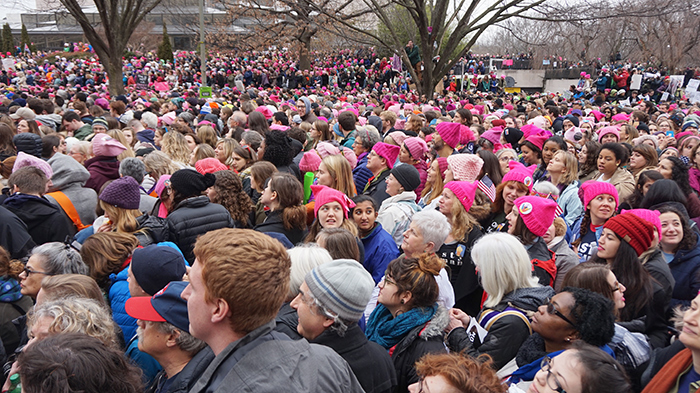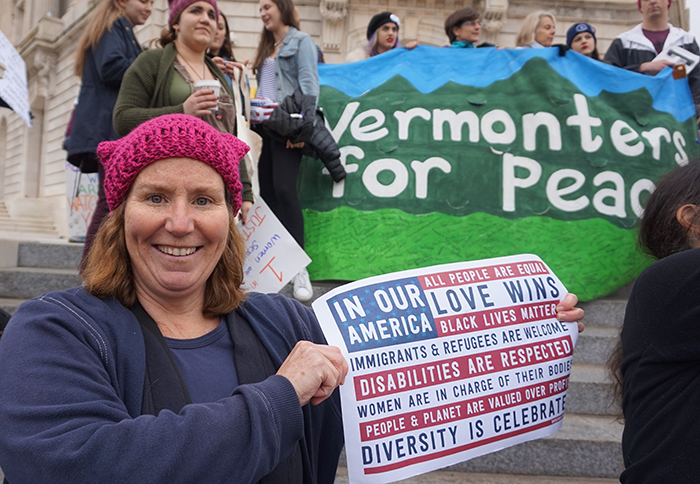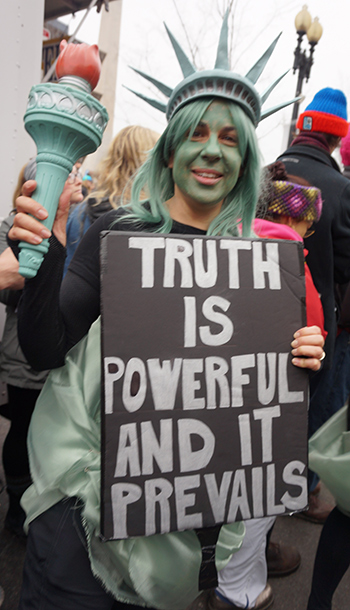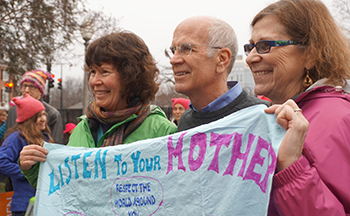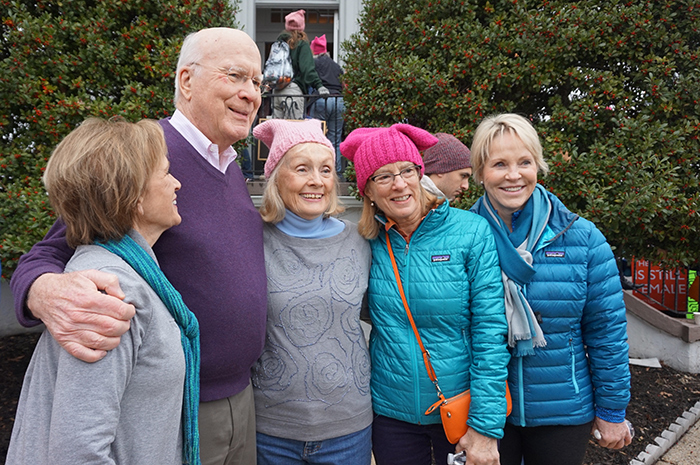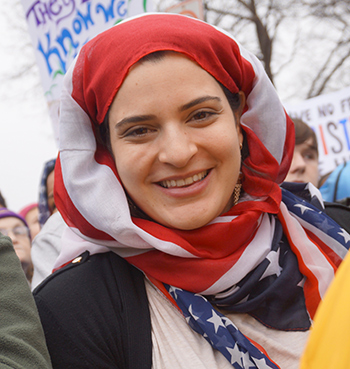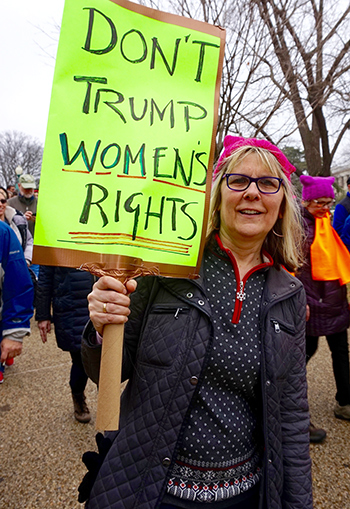Taking It to the Streets:Pussies on Parade: |
||||||||||
| Text and Photos by Susan Z. Ritz | ||||||||||
|
||||||||||
As soon as I heard about the Women’s March in Washington, DC, I knew I had to be there. I had been devastated by Hillary Clinton’s loss to Donald Trump and needed a way to channel my complete despair. Little did I know back then in November, when I booked my ticket on Amtrak, that I was just one of five million people across the globe preparing to march on January 21 to protect the rights and safety of women, the disabled, minorities, the LGBTQA community, and the most marginalized among us.
The idea for the march originated when two women, Theresa Shook, a retired attorney and grandmother in Hawaii, and New York fashion designer Bob Bland independently, an ocean and a continent apart, came up with a similar idea for organizing within two days of Trump’s shocking victory. It didn’t take long for thousands of women to sign up through Facebook and other social media sites. It also didn’t take long for calls to expand the leadership that many saw as too white, too old, and too wealthy to truly represent all American women. While Shook eventually stepped away from the national planning to organize in her home state, Bland recruited three young activists to join her as chairs of the march. Tamika Mallory, an African American gun control activist; Carmen Perez, head of Gathering for Justice and criminal justice reform advocate; and Linda Sansour, a Palestinian American and executive director of the Arab American Association of New York.
|
||||||||||
|
||||||||||
Besides Essex Junction, buses also came from Middlebury, the Barre-Montpelier area, and Brattleboro. Nonprofits, including Burlington’s Peace and Justice Center, Shelburne Farms, and the Vermont Natural Resources Council, hired their own buses. Many arranged carpools over Front Porch Forum or on Facebook pages, like Pantsuit Nation VT. Laureli Morrow of Montpelier flew in to Reagan National on a plane filled with women sporting hand-knit pink pussy hats, which adorned the heads of marchers everywhere, turning the march in DC as well as the sister marches into oceans of pink. The hats, brainchild of Los Angles screenwriter Krista Suh, took off when she published the knitting pattern online and thousands responded. Pink yarn sold out across the country as women began to knit them for themselves and for their friends and neighbors. In DC, the pink hats reminded some of the city’s famous cherry blossoms, blooming on an unusually mild day in January. On the train ride down, I sat cross from 80-year-old Ruth Magill, a retired school librarian from Williston who sported a giant safety pin, another unifying symbol for women opposed to Trump’s policies. Magill, who attended the march with her daughter, told me “I’m going to advocate for safety for people of diverse cultures. We need to bring hope to people who feel despair.”
Though 400 guests had registered for the event, over 900 showed up. By the time I got there, the coffee and pastries were long gone, but marchers were still gathered, getting photos taken with the senator and his wife, Marcelle, who wore a pale pink pussy hat. Rep. Peter Welch was also on hand to cheer on the Vermonters. After catching up briefly with my daughter who had come up from North Carolina with her fiancé, I was off to the Cannon House Office Building where Vermonters gathered on the steps. Several held a giant banner proclaiming “Vermonters for Peace.” Eventually, the Vermonters joined the flood of people heading toward the rally outside the American Indian Museum at Independence and Third. The march was to begin at 1 p.m., but because so many unscheduled speakers, including an outspoken Madonna, showed up, the rally continued until almost 3:30. Finally, the march made its slow way down Constitution Avenue toward the Washington monument, then on to the White House.
Feminist icon Gloria Steinem, almost 83, resplendent in her bright red suit, told us “Sometimes we must put our bodies where our beliefs are. Sometimes pressing send is not enough.” America Ferrera, daughter of Honduran immigrants, said, “We march today for the moral core of our nation against which our new president is waging war.” Scarlett Johannsen presented her personal story about how important Planned Parenthood had been for her when she was a young, poor teenager on her own in Los Angeles. Planned Parenthood president Cecile Richards, in shocking pink, backed that up saying “Planned Parenthood is the solution, not the problem,” and Michael Moore exhorted us to take action every day. Ashley Judd ignited the crowd with the slam poem “Nasty Woman” by 19-year-old Nina Donovan of Tennessee. I realized, as I watched the screen, that though I was familiar with the celebrities and older activists, I had no idea who the younger activists were up on the screen, many of them Asian, black, and Hispanic. I thought about President Obama’s exhortation for us to break out of our bubbles and decided to learn more about these emerging leaders. After a couple of hours, I struggled through the throng toward the National Mall where I was able to walk at a brisk pace, unlike the slow-moving march on the proscribed route on Independence and Constitution Avenues. The sea of pink hats flowed down the Mall, completely covering spaces that were empty the day before for Trump’s less well attended inaugural. According to crowd scientists, the women’s march crowd was three times larger than the inaugural crowd, a fact that still rankles the new president. I made my way with thousands of others carrying some original and inventive signs like “Other women’s bodies are not our battleground!,” “Our rights are not up for grabs. Neither are we,” and “This march is not fake news!”—along with many that said “Love Trumps Hate” and “I’m with Her!” with arrows pointing in all directions. Many Vermonters safety-pinned to their coats patches that read “Vermont—Fight Fascism” made by the Peace and Justice Center. Marchers who saw them all along the route called out thanks to our brave little state for consistently standing up against injustice. Carrie Baker Stahler of Montpelier, who attended the march with her husband, Nathan, carried a sign her 8-year-old daughter, Moxie, suggested she make: “Hate cannot drive out hate. Only love can do that.” As we marched, we chanted “This is what democracy looks like!” and “We want a leader, not a creepy Tweeter!” I ended up behind a lively band of women drummers and danced my way past the Washington Monument and on to the White House. There, marchers left their signs like a carpet of national discontent on the large lawn outside the back fence. Many of the signs were later collected by museums and archivists as evidence of a day that will go down in history and be carried in the memories of millions.
|
||||||||||
|
Susan Z. Ritz lives, writes, and marches on in Montpelier.
|
|||||||||
